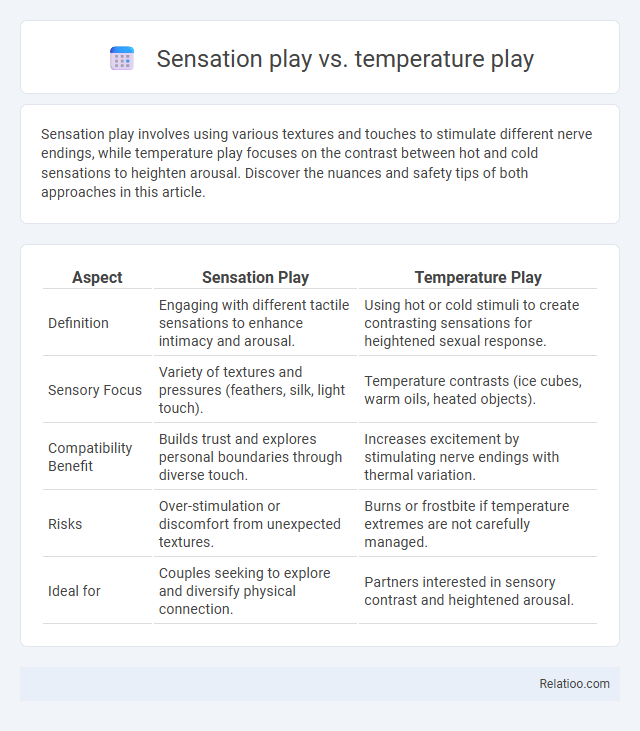Sensation play involves using various textures and touches to stimulate different nerve endings, while temperature play focuses on the contrast between hot and cold sensations to heighten arousal. Discover the nuances and safety tips of both approaches in this article.
Table of Comparison
| Aspect | Sensation Play | Temperature Play |
|---|---|---|
| Definition | Engaging with different tactile sensations to enhance intimacy and arousal. | Using hot or cold stimuli to create contrasting sensations for heightened sexual response. |
| Sensory Focus | Variety of textures and pressures (feathers, silk, light touch). | Temperature contrasts (ice cubes, warm oils, heated objects). |
| Compatibility Benefit | Builds trust and explores personal boundaries through diverse touch. | Increases excitement by stimulating nerve endings with thermal variation. |
| Risks | Over-stimulation or discomfort from unexpected textures. | Burns or frostbite if temperature extremes are not carefully managed. |
| Ideal for | Couples seeking to explore and diversify physical connection. | Partners interested in sensory contrast and heightened arousal. |
Understanding Sensation Play: A Comprehensive Overview
Understanding sensation play involves exploring various techniques like temperature play and impact play, each targeting different sensory experiences for heightened pleasure. Temperature play uses elements such as ice or warm wax to stimulate nerve endings through contrasting sensations, enhancing arousal and connection. Your exploration of sensation play can deepen intimacy and trust by carefully balancing stimulation, safety, and personal preferences.
Exploring Temperature Play: Definition and Variations
Temperature play involves using hot or cold stimuli to create contrasting sensations on the skin, enhancing sensory experience and intimacy. Variations include ice cubes, warming oils, heated massage stones, and chilled metal implements, each providing unique tactile contrasts that heighten arousal and sensitivity. Sensation play broadly encompasses any activity focused on stimulating the senses, including touch, sound, and taste, with temperature play as a specialized subset offering distinct thermal contrasts.
Key Differences Between Sensation and Temperature Play
Sensation play involves stimulating your skin using a variety of textures and pressures to create different feelings, while temperature play specifically utilizes hot or cold elements to awaken nerve endings and heighten sensitivity. The key difference lies in the method of stimulation: sensation play focuses on varied touch and materials, whereas temperature play targets thermal contrasts to provoke sensations. Understanding these distinctions helps you choose the most effective technique for personalized sensory exploration and enhanced intimate experiences.
Common Tools and Implements for Sensation Play
Common tools and implements for sensation play include feathers, silk scarves, and soft brushes designed to stimulate nerve endings with varied textures. Temperature play often uses items like ice cubes, warm massage oils, or heated stones to create contrasting thermal sensations on the skin. Your exploration of sensation play benefits from understanding these implements, as each offers unique tactile experiences that heighten intimacy and sensory awareness.
Safe Materials and Methods for Temperature Play
Sensation play explores diverse tactile experiences, while temperature play specifically involves the use of hot and cold stimuli to heighten arousal, requiring careful attention to safe materials and methods. Safe temperature play utilizes tools such as stainless steel, silicone, and glass, which distribute heat evenly and resist thermal shock, minimizing the risk of burns or injuries. Your safety depends on employing temperature play techniques like testing the temperature on your skin first, avoiding extreme heat or cold, and using safe materials designed for body contact.
Psychological Benefits of Sensation vs Temperature Play
Sensation play engages your nervous system through varied tactile experiences, enhancing emotional intimacy and heightening body awareness. Temperature play specifically manipulates thermal stimuli, which can trigger unique psychological responses such as increased arousal and stress relief by activating the body's thermoreceptors. The psychological benefits of sensation play generally promote deep relaxation and mindfulness, while temperature play intensifies sensory contrast, potentially amplifying emotional release and euphoria.
Risk Awareness and Safety Precautions
Sensation play involves various tactile stimuli to evoke physical and emotional responses, whereas temperature play specifically uses hot or cold elements to heighten sensations, requiring careful monitoring to avoid burns or frostbite. Risk awareness for sensation play includes recognizing individual limits and potential allergies, while temperature play demands precise temperature control and immediate response to skin reactions. Safety precautions for both involve constant communication, safe words, and ensuring all materials are clean and non-toxic to prevent injury or infection.
Communication and Consent in Sensation-Based Activities
Effective communication and clear consent are fundamental in sensation play, temperature play, and other sensation-based activities to ensure safety and mutual enjoyment. Participants must openly discuss boundaries, preferences, and limits before engaging, with ongoing check-ins to adjust intensity or stop if discomfort arises. Establishing safe words or signals enhances trust and allows immediate cessation of activities, maintaining a respectful and consensual environment.
Beginners’ Guide: Starting with Sensation or Temperature Play
Sensation play and temperature play are distinct yet complementary aspects of BDSM focusing on enhancing physical feelings; sensation play involves stimuli like feathers, ice, or light touches to awaken nerve endings, while temperature play specifically uses hot or cold objects to create contrasting thermal sensations. For beginners, starting with sensation play is often recommended because it allows gradual exploration of tactile sensitivity without the intensity or risk associated with extreme temperatures. Essential safety tips include using body-safe materials, communicating boundaries clearly, and having a safe word to ensure a consensual and enjoyable experience.
Enhancing Intimacy: Integrating Both in Your Relationship
Sensation play explores various tactile experiences using touch, pressure, and texture, while temperature play specifically involves contrasting sensations of hot and cold to heighten sensory awareness. Integrating both methods enhances intimacy by deepening physical connection and fostering trust through controlled, shared vulnerability. Your relationship benefits from this dynamic interplay, encouraging communication and expanding sensory boundaries for a richer, more immersive experience.

Infographic: Sensation play vs Temperature play
 relatioo.com
relatioo.com